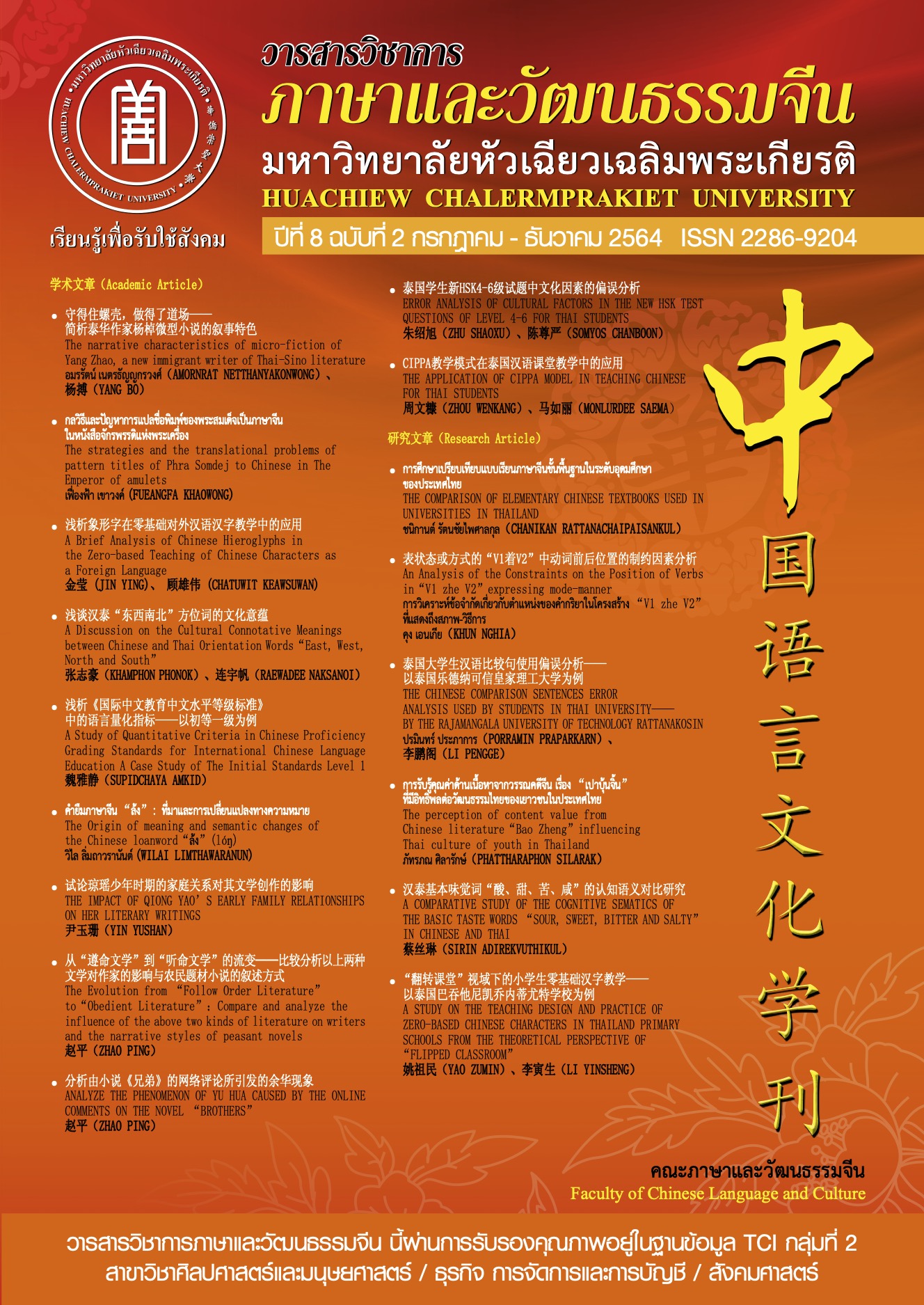THE CHINESE COMPARISON SENTENCES ERROR ANALYSISUSED BY STUDENTS IN THAI UNIVERSITY ——BY THE RAJAMANGALA UNIVERSITY OF TECHNOLOGY RATTANAKOSIN
Keywords:
Chinese comparison sentence Thai students Error analysisAbstract
ABSTRACT
Comparative sentences are an important part of Chinese learning, and it is also a difficult point for foreign students in the process of learning Chinese. In my Chinese teaching process, I found that Thai students encountered a lot of difficulties and mistakes when learning and using Chinese comparative sentences. In order to improve students’ mastery and use of Chinese comparative sentences, this article starts from the structure, semantic analysis, and pragmatic value of Chinese comparative sentences, combined with the actual learning of Thai students, and focuses on the errors in learning Chinese comparative sentences. The teaching strategies of comparative sentences are discussed.
This paper analyzes in detail the two types of errors in the basic format of comparative sentences and the errors in variable formats, and uses a questionnaire survey to understand the situation of Thai university students mastering Chinese comparative sentences.
The error in the basic format of the comparison sentence will be analyzed from "A+B+C format error" and "comparative sentence and the "same" sentence". The error in the change format will be analyzed from "A+比+B+C" Analyze with "A+compared to B+C", "A+B (phase) ratio+(A)C" and "A+compared to B+(A)C",
Through analysis, it summarizes the problems that Thai college students have in Chinese comparative sentences, and provides an effective reference basis for Chinese teachers in the future. It is hoped that through the research of this article, Thai Chinese teachers will pay great attention to the teaching of Chinese comparative sentences, so as to correctly use Chinese comparative sentences and reduce errors.
References
[1] 田煜,谢晓明,汉语比较句二语教学刍议.[J].云南师范大学学报,2019,04:9-16
[2]张磊.汉语差比句句法结构的制图分析.[J].鲁东大学学报,2019,04:38-43
[3]郭洁,顾阳.汉语比较句引介词的功能特征再析.[J]语言科学,2017,06:586-597
[4]耿直. 从“词汇—构式”视角看汉语比较句式的界定.[J].河南师范大学学报,2019,01:125-131
[5]季艳. 对外汉语比较句偏误分析及教学对策研究.[J].宿州教育学院学报,2017,01:117-118
[6]叶诗雨. 初级汉语水平的对外汉语比较句教学设计.[J].艺术科技,2016,04:358-359
[7]李美琴. 泰国学生汉语比较句习得偏误分析.[J].海外华文教育,2017,04:510-524
[8]陈小燕. 汉泰比较句对比研究及对泰初、中阶段教学启示:[硕士学位论文].[D].山东:山东大学,2013
[9] 胡亮节.泰国学生汉语比较句习得偏误分析:[硕士学位论文].[D],云南:云南师范大学,2006.
[10] 蒋静.比较句的语义偏向及主观程度的差异“不如”句、“不比”句和“没有(没)”句,[J],上海,上海师范大学学报(哲社版),2003,(4).
[9] 李临定现.代汉语句型,[M],北京:商务印书馆,1986.
[10] 李向农.再说“跟。。。。。一样”及其相关句式,[J],语言教学与研究,1999,(3).
[11] 陆检明. “还”和“更”。语言学论丛,[M],北京:商务印书馆,1980.
[12] 夏群.汉语比较句研究综述[J],延边,汉语学习,2009,(2).
Downloads
Published
How to Cite
Issue
Section
License
บทความที่ได้รับการตีพิมพ์เป็นลิขสิทธิ์ของวารสารภาษาและวัฒนธรรมจีน มหาวิทยาลัยหัวเฉียวเฉลิมพระเกียรติ
บทความใน “วารสารวิชาการภาษาและวัฒนธรรมจีน” เป็นทรรศนะของผู้เขียนโดยเฉพาะ กองบรรณาธิการไม่มีส่วนในความคิดเห็นในข้อเขียนเหล่านั้น




